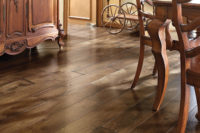Market Trends 2013: Confidence, Enthusiasm Lead the Way








This January, in his keynote address at InSight 2013, the Shaw Flooring Network annual convention at the Rosen Shingle Creek Resort in Orlando, Fla., Shaw CEO Vance Bell gave his thoughts on where the market is headed in 2013:
“I believe 2013 is going to be a better year for all of us. I’m certain you can sense the upturn, the opportunity, and the need to prepare for growth and success. It is so refreshing to stand in front of customers and say with certainty, for the first time in 5 years, that things are looking up and the future looks bright.”
Not a lot of room for misinterpretation there.
As part of an on-going effort to stay current on key industry issues and market trends,Floor Trends sponsors several market studies each year. These quantitative studies serve as the foundation for an ongoing series of educational features designed to provide a deeper, more thoughtful look at the state of the floor covering industry.
BNP Media’s Market Research Division, in conjunction with Floor Trends,conducted the 2013 Market Trends Study to elicit detailed information on the current state of the flooring market and future trends in the industry. Specifically, the study seeks to identify:
• The top selling product types in 2012
• The expected product growth for 2013
• Current market conditions compared to last year and future outlook
• Product attributes of priority when selecting/purchasing a specific manufacturer/brand of floor covering
• Current challenges facing floor covering dealers/contractors
The survey went out in November 2012 to6,686 active, qualified domestic Floor Trends subscribers, selected on an Nth name basis, whose primary business is flooring dealer/contractor.
Suffice to say, 2012 was not the Year of Recovery that many hoped it would be. Uncertainty in Washington – fiscal cliff, anyone? – was no help in trying to entice slightly optimistic (yet still cautious) consumers to enter the market. Add increasingly cutthroat competition and pricing pressure, and the retail landscape was…fluid, at best.
That said, last year’s biggest concern – pricing – dropped from the top slot in this year’s study. The new No.1? Big Box Store competition. Respondents cited issues and practices including “misinforming the public” “deceptive advertising” and “manufacturers selling to the Big Box stores” and more to boost this issue to the top of the list.
Interestingly, though, this concern does not seem to weigh as heavily on respondents as the pricing issue did in 2012; when asked to evaluate current business conditions compared to a year prior, 52% answered “much” or “slightly better,” while 18% said “slightly worse” and just 3% selected “much worse” to describe conditions.
That said, respondents’ outlook for 2013 is much the same as it was in 2012: 61% believe that business conditions over the next 12 months will be “slightly better” or “much better” than they are today (Chart 1), while 72% expect their gross annual sales to increase “slightly” or “significantly” compared to last year with a mean expected increase of 18% (Chart 2).
As you might expect, this perceived upturn in sales will only increase companies’ operational tempo. Retailers and contractors seeking an advantage in the market recognize the need to stay abreast of the latest technologies and marketing opportunities as they are being rolled out in an ever-quickening business cycle. Marketing and advertising (47%), computers/software (36%) and training and education (35%) are the top three areas in which respondents say they will be increasing investment in the next 2 years.
The segments of the industry respondents say are currently generating the most business (Chart 3) are worth noting. Residential replacement makes up 52% and contract/commercial business 17% of sales for respondents, while new construction in the residential and commercial sectors make up just 13% and 8% of sales, respectively.
Have you ever wondered why your peers sell the brands they sell? After taking price off the table, survey respondents named “product quality” as the No. 1 factor/characteristic that most affects their decision to promote or sell a specific brand of flooring; “manufacturer/rep support” and “design/color/style availability” follow soon after.
That said, when asked to rate the importance of various attributes when selecting or purchasing a specific brand, scheduling and on-time delivery is “very” or “extremely” important to 91% of respondents; 89% gave the same importance to responsiveness in handling claims and services.
Not too long ago, the digital domain was viewed with skepticism or even disdain within much of the floor covering community. Today, even the most ardent naysayer will grudgingly acknowledge the vital and rapidly growing role of e-commerce in the industry landscape. Curiously, though, when asked how they prefer to interact with manufacturers when specifying or purchasing floor coverings (Chart 4), 65% of respondents still cited “work with a local manufacturer’s rep/distributor” and even prefer direct contact with an in-house manufacturer employee by a more than 4:1 margin over going through a manufacturer’s website.
Environmental responsibility is another area that’s seen a rapid rise to prominence in recent years. But that ascent may be slowing somewhat; last year 76% of respondents saw a trend toward “environmentally responsible” flooring products and materials, while just 64% said the same thing this year. Along those same lines, 20% call themselves “quite familiar” or “very familiar” with the U.S. Green Building Council’s LEED rating system compared to 26% in 2012. Similar to last year, 60 percent of respondents find manufacturer EPDs (Environmental Product Declarations) “somewhat,” “quite” or “very” valuable in making a sale.
The Floor TrendsMarket Study Series is intended to help manufacturers and retailers better understand their markets and, more importantly, each other. This article is a snapshot of a comprehensive study examining trends and opinions in and of the floor covering industry. The conclusions are based on the opinions, preferences and purchasing behavior of industry professionals who agreed to participate in the survey.
Looking for a reprint of this article?
From high-res PDFs to custom plaques, order your copy today!












